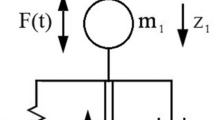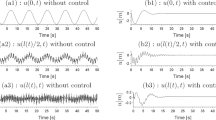Abstract
In this paper we present the modeling of an airship with a load suspended by a flexible heavy cable. The objective is to determine a control law that allows to stabilize the machine and its load under the effect of a gust of wind. In order to overcome the great inertia of the airship and the impossibility of using the accelerations of the latter to attenuate the oscillations of the suspended load, a new actuator was proposed at the exit of the cable in order to control its oscillations, namely a motorized cardan joint. The methodology of the study consisted of extracting a reduced dynamic model, which allowed us to build a robust control vector in order to stabilize the suspended load. The analysis of the stability of the zero dynamics of the system was carried out by means of the phase portraits of Poincaré. Numerical simulations were carried out and demonstrated the interest of our approach.



















Similar content being viewed by others
References
Liao, L., Pasternak, I.D.: A review of airship structural research and developments. Prog. Aerosp. Sci. 45(4–5), 83–96 (2009)
Manikandan, M., Pant, R.: Research and advancements in hybrid airships—a review. Prog. Aerosp. Sci. (2021). https://doi.org/10.1016/j.paerosci.2021.100741
Bisgaard, M., la Cour-Harbo, A., Bendtsen, J.D.: Full state estimation for helicopter slung load system. In: AIAA Guidance, Navigation, and Control Conference, Hilton Head, SC, vol. 4, pp. 4036–4050 (2007)
Oh, S.R., Ryu, J-C., Agrawal, S.K.: Dynamics and control of a helicopter carrying a payload using a cable-suspended robot. J. Mech. Des. 128(5), 1113–1121 (2006). https://doi.org/10.1115/1.2218882
Dukes, T.A.: Maneuvering heavy sling loads near hover part I: damping the pendulous motion. J. Am. Helicopter Soc. 18(2), 2–11 (1973)
Guerrero, M.E., Mercado, D.A., Lozano, R., García, C.D.: Ida-pbc methodology for a quadrotor UAV transporting a cable-suspended payload. In: 2015 International Conference on Unmanned Aircraft Systems (ICUAS), Denver, CO, USA, pp. 470–476 (2015). https://doi.org/10.1109/ICUAS.2015.7152325
Us, K.Y., Cevher, A., Sever, M., Kirli, A.: On the effect of slung load on quadrotor performance. Proc. Comput. Sci. 158, 346–354 (2019)
Cruz, P.J., Oishi, M., Fierro, R.: Lift of a cable-suspended load by a quadrotor: a hybrid system approach. In: American Control Conference (ACC), pp. 1887–1892 (2015). https://doi.org/10.1109/ACC.2015.7171008
Oh, S.R., Mankala, K.K., Agrawal, S.K., et al.: Dynamic modeling and robust controller design of a two-stage parallel cable robot. Multibody Syst. Dyn. 13, 385–399 (2005). https://doi.org/10.1007/s11044-005-2517-8
Wang, X., Shan, X.: Airship attitude tracking system. Appl. Math. Mech. 27(7), 919–926 (2006)
Sang-Jong, L., Dong-Min, K., Hyo-Choong, B.: Feedback linearization controller for semi station keeping of the unmanned airship. In: AIAA 5th ATIO and 16th Lighter-Than-Air Sys Tech. and Balloon Systems Conferences, p. 7343 (2005)
Chang-Su, P., Hyunjae, L., Min-Jea, T., Hyochoong, B.: Airship control using neural network augmented model inversion. In: Proceedings of 2003 IEEE Conference on Control Applications, vol. 1, pp. 558–563 (2003). https://doi.org/10.1109/CCA.2003.1223497
Hauser, J., Sastry, S., Meyer, G.: Nonlinear control design for slightly non-minimum phase systems: application to v/stol aircraft. Automatica 28(4), 665–679 (1992)
Spong, M.W., Block, D.J.: The pendubot: a mechatronic system for control research and education. In: Proceedings of the 34th IEEE Conference on Decision and Control, vol. 1, pp. 555–556 (1995)
Pérez Polo, M.F., Molina, M.P., Chica, J.G.: Swingup and positioning control of an inverted wheeled cart pendulum system with chaotic balancing motions. Int. J. Non-Linear Mech. 47(6), 655–665 (2012)
Spong, M.W.: Energy based control of a class of underactuated mechanical systems. IFAC Proc. Vol. 29(1), 2828–2832 (1996)
Azouz, N., Khamlia, M., Lerbet, J., Abichou, A.: Stabilization of an unconventional large airship when hovering. Appl. Sci. 11(8), 3551 (2021). https://doi.org/10.3390/app11083551
Chaabani, S., Azouz, N.: Estimation of the virtual masses of a large unconventional airship based on purely analytical method to aid in the preliminary design. Aircr. Eng. Aerosp. Technol. (2021). https://doi.org/10.1108/AEAT-12-2020-0304
Fossen, T.I.: Guidance and Control of Ocean Vehicles. Wiley, New York (1994)
Meirovitch, L.: Hybrid state equations of motion for flexible bodies in terms of quasi-coordinates. J. Guid. Control Dyn. 14(5), 1008–1013 (1991)
Meirovitch, L., Stemple, T.: Hybrid equations of motion for flexible multibody systems using quasicoordinates. J. Guid. Control Dyn. 18(4), 678–688 (1995)
Kane, T.R., Ryan, R., Banerjee, A.K.: Dynamics of a cantilever beam attached to a moving base. J. Guid. Control Dyn. 10(2), 139–151 (1987)
Piedboeuf, J.: Six methods to model a flexible beam rotating in the vertical plane. In: Proceedings 2001 ICRA. IEEE International Conference on Robotics and Automation (Cat. No. 01CH37164), Seoul, South Korea, vol. 3, pp. 2832–2839 (2001). https://doi.org/10.1109/ROBOT.2001.933051
Du, J., Agrawal, S.K.: Dynamic modeling of cable-driven parallel manipulators with distributed mass flexible cables. J. Vib. Acoust. 137(2), 021020 (2015). https://doi.org/10.1115/1.4029486
Meirovitch, L.: Fundamentals of Vibrations. McGraw-Hill, Boston (2001)
Poincaré, H.: Mémoire sur les courbes définies par une équation différentielle (i). J. Math. Pures Appl. 7, 375–422 (1881)
Poincaré, H.: Mémoire sur les courbes définies par une équation différentielle (ii). J. Math. Pures Appl. 8, 251–296 (1882)
Poincaré, H.: Sur les courbes définies par les équations différentielles (iv). J. Math. Pures Appl. 2, 151–218 (1886)
Asada, H., Slotine, J.-J.E.: Robot Analysis and Control. Wiley, New York (1986)
Leitmann, G.: The Calculus of Variations and Optimal Control. Mathematical Concepts and Methods in Science and Engineering. Springer, New York, USA (1981)
Petit, N., Rouchon, P.: Flatness of heavy chain systems. SIAM J. Control Optim. 40(2), 475–495 (2001)
Author information
Authors and Affiliations
Corresponding author
Additional information
Publisher’s Note
Springer Nature remains neutral with regard to jurisdictional claims in published maps and institutional affiliations.
Appendix
Appendix
The discretized kinetic energy is written as:
To simplify the writing of kinetic energy, the following intermediate quantities are used:
The potential energy is discretized as follows:
with:
\(B\) the damping matrix:
\(K\) the stiffness matrix:
Rights and permissions
About this article
Cite this article
Azouz, N., Khamlia, M., Lerbet, J. et al. Modelling and stabilization of a load suspended by cable from an airship. Multibody Syst Dyn 55, 399–431 (2022). https://doi.org/10.1007/s11044-022-09831-2
Received:
Accepted:
Published:
Issue Date:
DOI: https://doi.org/10.1007/s11044-022-09831-2




